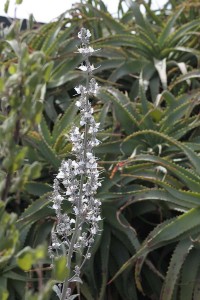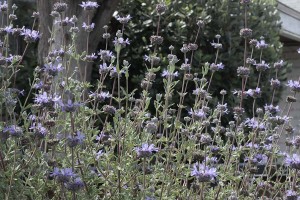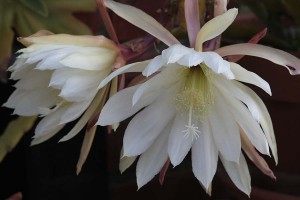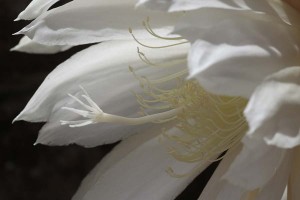We begin this month’s episode of Garden Bloggers’ Bloom Day with the rare lavender-flowered California coffeeberry. Well, actually, there is no such thing and I’m making it up, using one of the older trick in the gardener’s book.
The flowers come from Verbena bonariensis, a tall, stemmy plant that sends it flowers up through any plants around it, making them appear as if they’re blooming with the verbena’s flowers.
The coffeeberry’s flowers are much more nondescript to humans. On the recent garden tour I spoke to a homeowner who was wishing that she hadn’t planted her coffeeberries so close to paths because the bugs seem to go crazy over its blooms, more so than just about any other native plant. Here we have the humble blooms of Frangula (Rhamnus) californica ‘Eve Case.’
The rest of the garden is definitely slowing down. The last few months have been high spring, but you can feel summer’s presence in the lengthening days and the plants slowing down their growth and flower production.
Fortunately some plants choose this time to begin flowering. White sage, Salvia apiana, is one of them.
San Miguel Island buckwheat, Eriogonum rubescens var. rubescens, just getting going.
Winnifred Gilman Cleveland sage, close to its peak.
Gutierrezia californica, California matchweed. It’s not a usual home garden plant, but it has delicate and tiny yellow flowers and miniature leaves that contrast nicely against larger, more substantial plants.
Saint Catherine’s lace, Eriogonum giganteum, probably the most stunning buckwheat. That’s “stunning” in buckwheat-speak, meaning it’s spectacular in a really humble way. Here it is, holding its own against a phlomis from Turkey, P. monocephala.

A closer look at the phlomis above.
We also have a pretty heavy flowering of Island bush snapdragon, Galvezia speciosa ‘Firecracker.’ Looking close, you can definitely make out its family resemblance to the common garden snappers.

A close look at the “rat-tail” floral structures of Verbena lilacina. This species has coloration identical to the verbena that opened this post, but it’s more shrubby, and comes from Baja, not Brazil.
Clarkia rubicunda ssp. blasdalei helps extend the flowering into late spring.
If you let your California poppies go to seed, you’ll likely have little scenes like this, young poppy plants sending out their first blooms–not always in the best of places, but there are usually enough of them that some will be coming up where you’d like them.
On the carnivorous plants we have some new blooms. This is a sundew, Drosera filiformis, “Florida Giant.”
And buds on another sundew Drosera capensis, white form.
The pitcher plants, however, are slowing down their flower production, just as the plants start to put out the amazing pitchers that make us want to grow them. These are the intensely raspberry-scented blooms of the ancestral form of Sarracenia rubra var. gulfensis.
During a couple weeks in later spring the orchid cactus, epiphyllums, go crazy with flowers. There’s really nothing orchid-like to their flowers, and their common names is just a piece of wayward marketing. But dang they’re spectacular in their gaudy, tacky, over-the-top-ness. These plants are John’s obsession. Unfortunately he’s not big on plant labels, so here I can only offer you the most generic plant names:
“White epiphyllum”
“A different white epiphyllum,” a plant in total full bloom
A close inspection of the above, Epiphyllum albus differentus
“Red epiphyllum”
“Magenta epiphyllum”
To conclude I’ll share this first flower of the local red columbine, Aquilegia formosa, a species that I’ve always enjoyed but haven’t grown in 10-15 years. Here it is, returned to the garden at last (courtesy last fall’s native plant society sale). Welcome home. You were missed.
That’s a lot of what’s blooming in my garden. Check out dozens of other gardens [ here ] over at May Dreams Gardens, where Carol hosts the monthly bloom day meme on the 15th of each month. Thanks as always, Carol!



























I love your many epiphyllums… beautiful photos as well! Larry
Wow, lots going on, even if you say it’s slowing down. Love that E. giganteum – had to ditch mine, it really was getting too big.
Love those Epiphyllums as well – and of course the carniverous plants. What a relief to see some things that I don’t usually see.
Happy bloom day!
So fun to see what blooms are happening all around the world! Your last pic, the columbine, is a stunner! Happy GBBD! Cheers, Jenni
Nice photos. If the garden is fading, it is doing so gracefully. And then the raspberry-scented Sarcenia is awesome. I would definitely end up in one of those pitchers if I was a fly.
Wow! That’s a lot of pretty blooms!
I especially like the different cacti.
Happy Bloom Day!
Lea
Lea’s Menagerie
I’ve never grown carnivorous plants. They must be very interesting. There are certainly enough flying insects around here to feed them! Maybe I’ll try them. I do like that coffeeberry, also.
Love the open structure of the island buckwheat. A couple of crossover plants (Calif poppy, Clarkia) can be grown here successfully, but the rest seem quite exotic. Makes me feel like I have been on a little mini-vacation, reading your post.
Raspberry-scented pitcher plants? Gasp! At a recent plant sale I paused at the pitcher plant table but decided to try one of the easiest, the sundew Drosera capensis, so am thrilled to see your photos. I’ve been bad in the past keeping up with the strict pure water requirements of the sarracenia. And I think anyone would consider the giant buckwheat spectacular, nothing else quite like it. Wonderful post.
Lovely pics and I love your pretend plant. Thanks for sharing
You have such colorful and interesting plants in your garden. Love the pitcher plants (so exotic) and the verbena are wonderful too! Happy GBBD!
Your carnivorous plants are fascinating. Nice job documenting the Epiphyllum albus differentus, too. Perhaps John could use your help labeling his plants in the future?
I bought a San Miguel Island buckwheat recently, so the picture of yours gives me hope that mine may bloom soon. I also bought a columbine at this spring’s CNPS sale, just like you did. Unfortunately the flower stalk on mine fell off before I managed to get a decent photograph of it. But the plant itself is healthy and now planted in the ground, where I hope it will produce new flower stalks.
You had me at “intensely raspberry-scented blooms”.
Beautiful images!
Enjoying your post and others’ bloom day posts…swamped and all over this week. Amazing selection you have and are about to have…
Great plants! Does coffeeberry reseed like crazy for you?
Epiphyllums–yeah, they create mixed feelings, don’t they? Unearthly wild flowers for a few weeks, an ugly plant to hide behind the nearest shrub the rest of the year.
I have my own new species http://patientgardener.wordpress.com/2012/05/19/4913/
If you trimmed the Phlomis detail, you may be surprised what you will find!
If you trimmed the Phlomis detail, you may be surprised what you will find!